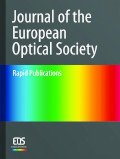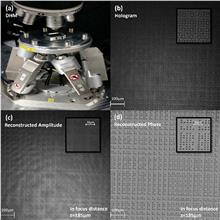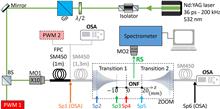 View fulltext
View fulltext
In this work a three-dimensional diffusion model is used to model photopolymers as a recording media. This model allows us to predict the properties of the Diffractive Optical Elements (DOEs) once we recorded into the photopolymer. This model had never been tested with more complex elements, such as multifocal diffractive lenses, as presented in the following in this work. In addition, the model includes; the estimation of the refractive index modulation, the low-pass filtering effect due to the experimental optical setup, and the evolution of the transverse intensity distribution. In this way, the selection of the appropriate material characteristics depending on the intended DOE application is made possible. Specifically, an acrylamide-based PVA/AA photopolymer is simulated using the proposed model. Moreover, coverplating and index matching systems are considered together to avoid the effects of thickness variation. Furthermore, in order to compare their properties using the proposed model, we focus on Fibonacci lenses (FL), a type of bifocal lenses. This allows us to evaluate the dependence of the focii intensity on the polymerisation rate, the diffusivity parameter, low-pass filtering effect and the use of the index matching system for these lenses. This enables us to know the recording parameters in order to produce this type of multifocal diffractive lenses with higher quality and precision.
Orbital Angular Momentum (OAM) multiplexing is a technology of communication systems that enables high-capacity optical communication networks. One of the most important determinants of this technology is the channel capacity, loss of power, and Bit Error Rate (BER) accompanying the transmission. This article proposed an Orbital Angular Momentum (OAM)/Spatial Domain Multiplexing (SDM) Gigabit-capable Passive Optical Network (G-PON) architecture for a Multiple-Input Multiple-Output (MIMO) communication system that supports (OAM/SDM G-PON) technology. The proposed architecture is used to multiplex the downstream OAM channels and the upstream SDM channels, and an OAM multiplexer/demultiplexer (OAM-MUX/DEMUX) is used to multiplex and demultiplex the OAM channels. In the OAM/SDM G-PON system, the signal will propagate through three different mediums, each having its own nature in influencing the power of the signal that passes through that medium. The experiment involves bidirectional transmissions with a DS/US data rate of 2.4 Gbps and Binary Phase Shift Keying (BPSK) downstream and 1.2 Gbps upstream. The observed results showed that the bit-error rate (BER) is a function of coupling angles and increases with the increase in the OAM ring size.
Deep neural networks (DNNs) are increasingly employed across diverse fields of applied science, particularly in areas like computer vision and image processing, where they enhance the performance of instruments. Various advanced coherent imaging techniques, including digital holography, leverage different deep architectures like convolutional neural networks (CNN) or Vision Transformers (ViT). These architectures enable the extraction of diverse metrics such as autofocusing reconstruction distance or 3D position determination, facilitating applications in automated microscopy and phase image restitution. In this work, we propose a hybrid approach utilizing an adapted version of the GedankenNet model, coupled with a UNet-like model, for the purpose of accessing micro-objects 3D pose measurements. These networks are trained on simulated holographic datasets. Our approach achieves an accuracy of 98% in inferring the 3D poses. We show that a GedankenNet can be used as a regression tool and is faster than a Tiny-ViT (TViT) model. Overall, integrating deep neural networks into digital holographic microscopy and 3D computer micro-vision holds the promise of significantly enhancing the robustness and processing speed of holograms for precise 3D position inference and control, particularly in micro-robotics applications.
A highly sensitive distributed measurement technique is employed to map supercontinuum generation along a tapered silica optical fiber. This technique, which utilizes a confocal Raman micro-spectrometer, relies on analyzing far-field frequency-resolved Rayleigh scattering along the waveguide with micrometer-scale spatial resolution and high spectral resolution. Non-destructive and non-invasive, the mapping system enables observation of every stage of supercontinuum generation along the fiber cone, including cascade Raman scattering, four-wave mixing, and dispersive wave generation. Consequently, it unveils unique nonlinear spatial dynamics that are beyond the reach of standard spectral analyzers.
We report a new and more precise Sellmeier equation obtained by using the analysis of quasi-phase-matching curves of the optical parametric generation (OPG) in 1D periodically poled LiTaO3 (1D-PPLT) of different grating periods.
Industrial processes such as smelting and sintering require stable and precise temperature control of furnaces. To achieve this, accurate temperature measurements are required. Pyrometry allows for contactless measurement of bulk materials and is particularly suitable for high temperature applications. One of the main influences on the accuracy of pyrometric measurements is the knowledge of the emissivity in the spectral measurement range. To reduce this dependence, two-color pyrometers or multi-color pyrometers can be used. With this in mind, the Institute of Space Systems (IRS) is further developing their existing pyrometer technology by designing an advanced multi-channel pyrometer for bulk oven processes in a joint venture with Stange Elektronik GmbH and New Generation Kilns Grün GmbH. The design approach is explained here and the considered methods of achieving emissivity independent temperature measurements are examined.
This paper describes an exceptionally high birefringent modified slotted core circular photonic crystal fiber (MSCCPCF). At the 1.55 μm telecommunication wavelength, the proposed fiber structure aims to achieve exceptional birefringence performance through the thoughtful placement of air holes and the incorporation of slots. The optical properties of the proposed MSCCPCF are rigorously simulated using the finite element method (FEM). The FEM simulations show high birefringence of up to 8.795 × 10−2 at 1.55 μm. The suggested fiber exhibits single mode behavior in the E to L communication bands (Veff < 2.405). Numerous geometric factors and their effects on other optical properties, such as birefringence, beat length (17.62 μm) and dispersion coefficient (−310.8 ps/(nm · km)) have been meticulously studied. The proposed fiber’s viability and potential uses are evaluated by analyzing modal features like nonlinearity (21.76 W−1 km−1), confinement loss (5.615 × 10−11 dB/cm), and dispersion. The proposed fiber structure has potential for use in polarization-maintaining devices, sensors, and other photonic applications requiring high birefringence and tailored optical properties.
We present the design of composite optical nanofibers (ONF) coated with thin layers of nonlinear materials, Titanium dioxyde (TiO2) and Polymethyl methacrylate (PMMA), for the realization of new all-solid Raman wavelength converters for an emission around 1.5 μm. Our simulations show that Stimulated Raman Scattering can be obtained with moderate input peak powers, typical ONF geometrical parameters, and layer thicknesses deposited which are technologically achievable: a few tens of nm for TiO2 and a few hundreds of nm for PMMA. This study enlarges the field of applications of ONF in nonlinear optics and lasers by opening the way to the coating by other materials such as doped polymers.
In this article, we investigate the coherent A1g phonon mode in bismuth crystal using transient reflectivity measurements, focusing on two distinct crystallographic orientations: one with the principal axis ((1 1 1)-direction in the trigonal cell representation) perpendicular to the sample surface, and the other with the principal axis parallel to the surface. Our results demonstrate significant variations in the amplitude, frequency, and lifetime of the coherent phonon mode between these two orientations, even when identical pumping and probing conditions are applied. We attribute these differences to the anisotropy of the electron effective mass, which influences electron mobility and, in turn, affects the phonon dynamics in bismuth.
We investigated the far-field terahertz beam profile generated from an air plasma induced by two-color femtosecond laser pulses. Under our experimental conditions (filament length shorter than the dephasing length between the two-color pulses), using electro-optic sampling in both ZnTe (0.2–2.2 THz) and GaP (0.4–6.8 THz) crystals, and ultra-broadband ABCD technique (1–17.5 THz), we determined that the THz beam exhibits a unimodal beam pattern below 4 THz and a conical one above 6 THz. This experimental finding is consistent with theoretical studies based on the unidirectional pulse propagation equation, which predict the transition of THz emission from a flat-top profile to a conical one due to the destructive interference of THz waves emitted from the plasma filament. Our results also underscore the importance of accounting for experimental artifacts, such as photo-excited losses in silicon resulting in on-axis THz absorption along with the influence of drilled mirrors, in characterizing the complex spatial and frequency-dependent behavior of two-color plasma-induced terahertz emission.
The design freedom of Additive Manufacturing offers new opportunities for the design of mounting structures of optical systems, which are not feasible for conventional manufacturing approaches, thus opening up new areas of application for optical systems. We use this to develop a fully monolithic mounting structure for precise positioning of the optical elements, while simultaneously increasing their robustness against harsh environmental conditions. We additively manufacture such a mounting structure for an imaging lens and evaluate its optical performance with interferometric measurement of its wavefront, before and after applying a mechanical shock to the entire system. The results indicate a centering accuracy better than 6 μm, both in the initial positioning as well as the subsequent repositioning after a mechanical shock of 15G.













